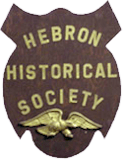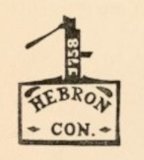
The Hebron Historical Society
Hebron, Connecticut
Enjoy Hebron - It's Here To Stay ™


Enjoy Hebron - It's Here To Stay ™

If ever you want a birds-eye view of Hebron history for a particular year, all you have to do is study the town’s annual report, and most especially those published in the early 20th century.
The town, it appears, took on responsibility for the schools, transporting students, care of the sick, maintenance of roads, and reimbursement to farmers for livestock killed by fox and wild dogs, as well as damage done to orchards by deer. The town was a major employer of the residents, as evidenced by the detailed ledger; every dime spent is carefully documented.
At times, it is pure comedy. On November 29, 1912, F. Slater was paid $2 for “Getting old horse out of road,” and the following day, D. A. Kellogg was paid $25 “For damage to horse by breaking through bridge in Turnerville.” We can only assume that Kellogg’s horse was rather old! Ben Jones was paid $32 “for damage to ox by breaking through bridge.” Either the bridges in town were in much need of repair, and/or the town took seriously its obligation to residents’ livestock traversing the bridges.
There are numerous entries “For lodging tramp” at the cost of 50 cents per day. Finally, on December 26, the town invested $5.55 for 26 ½ hours of labor and $2.20 for 221 feet of lumber for a “Building to keep tramps in.” Problem solved, for less than $10!
The town also paid for medical care of its residents: there are monthly entries of $17 payments to Hartford State Tuberculosis Sanitarium for Board of Chas. Thompson.” (Thompson’s care is also included in the 1909 Annual Report.) Dr. Cyrus H. Pendleton was paid $12.72 per year to serve as Town Health Officer. He was also paid $5.50 for “medical attendance for poor.”
Page after page records payment to local residents for work on the roads. The number of hours spent, as well as the total number of employees, was carefully documented. For example, H.C. Porter was paid $12 for “2 2/3 days with team on state road.” John Strickland was paid $4.85 for “for 2 days work on state road with boy.” Charles Ams, of Sterling Manufacturing fame, is mentioned frequently for the dynamite and bridge building services he provided the town.
Deer appeared to be a particular problem in 1912. There are numerous entries reimbursing residents, such as to W. H. Johnson, who received $20 “For damage done by deer to peach trees.” Alas, Mary Beckwith received only $3 for the “Damage done by deer” to her property. Others, such as Fred Prentice and H. E. Buell, received $1 for “Services as appraiser for deer damage.” The state reimbursed the town $75 for deer damage.
The Town School Committee also provided detailed information on everything spent. Teachers made $10 per week, and were reimbursed for any “extras” they provided (Daisy White received 10 cents for a box of crayons; Jennie Gilbert was paid an additional $1.20 for building fires.) Residents such as Arnold Baumberger, Dan Way, Wilbur Hills and Elton Buell were paid for transporting students to school – the modern day equivalent of school buses! Through these annual reports, we learn much about Hebron history, and how our community functioned as a highly integral, highly interdependent unit. Each annual report is worthy of a book.